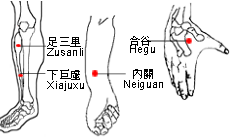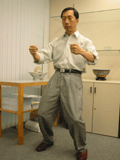Various TCM therapies can be used at any stage of the disease or in combination with Western treatment at any time. Individuals can benefit from its preventative effects, improve their quality of life or boost the immune system, relieve or eliminate adverse effects caused by chemotherapy, and even help in the palliative care of terminal cancer patients. The following methods are for general information only; a qualified physician should always be consulted for treatment options. Self-treatment is not recommended.
| Treatment based on TCM differential diagnosis |
Physicians select the treatment method according to TCM differential diagnosis, the "disharmony patterns" made by analyzing the collected data. All these remedies are adjusted to suit specific individual conditions.
Downward migration of damp-heat
Therapeutic aim: to clear away heat in order to drain dampness. Commonly used prescriptions are huaihua diyu tang, qingchang yin, or baitouweng tang.
Sample prescription: baitouweng tang (白頭翁湯)
| bai tou weng |
Root of Chinese Pulsatilla |
| huang lian |
Rhizome of Chinese Goldhread |
| huang bai |
Bark of Chinese Corktree |
| qin pi |
Chinese Ash Bark |
Excessive accumulation of poisonous pathogens
Therapeutic aim: to clear away heat to cool blood, remove stasis, and detoxify the body. Commonly used prescriptions are wuwei xiaodu yi and huanglian jiedu tang.
Sample prescription: huanglian jiedu tang (黃連解毒湯)
| huang lian |
Rhizome of Chinese Goldhread |
| huang qin |
Root of Baikal Skullcap |
| huang bai |
Bark of Chinese Corktree |
| zhi zi |
Fruit of Cape Jasmine |
Interior retention of blood stasis
Therapeutic aim: to clear away heat to cool blood, remove stasis, and detoxify the body. Commonly used prescriptions are wuwei xiaodu yi and huanglian jiedu tang.
Sample prescription: xiefu zhuyu tang (血府逐瘀湯)
| dang gui |
Chinese Angelica Root |
| sheng di |
Dried Rehmannia Root |
| tao ren |
Peach Seed |
| hong hua |
Safflower Flower |
| zhi ke |
Bitter Orange |
| chi zhao |
Common Peony Root |
| niu xi |
Twotooth Achyranthes Root |
| jie geng |
Balloonflower Root |
| chuan xiong |
Szechuan Lovage |
| chai hu |
Chinese Tororwax Root |
| gan cao |
Liquorice Root |
Deficiency in vital energy (qi) and blood
Therapeutic aim: to replenish qi and nourish the blood. Commonly used prescriptions are guipi tang and bazhen tang.
Sample prescription: guipi tang (歸脾湯)
| bai shu |
Large Head Atractylodes Root |
| fu ling |
Indian Bread |
| huang qi |
Mongolian Milkvetch Root |
| long yan rou |
Logan Aril |
| suan zao ren |
Spine Date Seed |
| ren shen |
Ginseng Root |
| mu xiang |
Root of Common Aucklandia |
| zhi gan cao |
Liquorice Root (processed with honey) |
| dang gui |
Chinese Angelica |
| yuan zhi |
Root of Thinleaf Milkwort |
| sheng jiang |
Rhizome of Common Ginger |
| da zao |
Common Jujube Fruit |
Yang deficiency in spleen and kidney
Therapeutic aim: to warm and tonify the spleen and kidneys. Commonly used prescriptions are zhenling baishu san and sishen wan.
Sample prescription: shenling baishu san (參苓白術散)
| ren shen |
Ginseng Root |
| fu ling |
Indian Bread |
| bai shu |
Large Head Atractylodes Root |
| bai bian dou |
White Hyacinth Bean |
| huai shan |
Chinese Yam |
| lian zi |
Seed of Hindu Lotus |
| sha ren |
Fruit of Villous Amomum |
| yi yi ren |
Seed of Job's Tears |
| jie geng |
Balloonflower Root |
| gan cao |
Liquorice Root |
Yin deficiency in liver and kidney
Therapeutic aim: to nourish and tonify the liver and kidney. A commonly used prescription is zhibai dihuang wan.
Sample prescription: zhibai dihuang wan (知柏地黃丸)
| shu di |
Processed Rhemannia Root |
| shan yu rou |
Asiatic Cornelian Cherry Fruit |
| huai shan |
Chinese Yam |
| dan pi |
Tree Peony Bark |
| fu ling |
Indian Bread |
| ze xie |
Oriental Water-plantain Root |
| zhi mu |
Common Anemarrhena Rhizome |
| huang bai |
Bark of Chinese Corktree |
Treatments other than the oral drugs include acupuncture, plasters, sauna, and massage. These methods are commonly applied to localized lesions according to the presentation of symptoms.
Acupuncture
To relieve pain and vomiting, selected acu-points are:
zu-san-li, tian-shu, he-gu, xia-ju-xu, nei-guan, and da-chang-shu.
 |
| Samples of acu-points that helps to relieve pain and vomiting. |
Moxibustion
This is suitable for colorectal cancer patients who have complications such as ascites (free fluid accumulating in the abdominal cavity). Selected acu-points are:
tian-shu, zhong-wan, xia-wan, guan-yuan, shen-quel.
Recommended treatment is 2-3 times daily.
Topical application of drugs
This refers to local application of pounded fresh medicinal herbs or moisturized medicinal powder over the affected part. They are applicable for local infections, ulcers, swelling, pain and injuries. In this case, individuals can apply to relieve pain caused by cancer, e.g. toad paste.
 |
| Application of TCM plaster for topical use. |
Enema
This refers to the introduction of a liquid into the bowel via the rectum, to be either expelled or retained. It is suitable for individuals with bloody stools. For example, a TCM decoction is prepared using the bark of Chinese Corktree (huang bai), root of Baikal Skullcap (huang qin), root of Redroot Growwell (zi cao), rhizome of Japanese Fleeceflower (hu zhang), common Picria herb (ku shen), and fruit of Japanese Apricot (wu mei).
| TCM patent drugs or simple folk remedies |
TCM has many patent drugs or simple folk remedies for relief of symptoms. Physicians usually prescribe these to complement other treatments.
This method is beneficial for regulating the body and mind, strengthening the constitution, and relieving the adverse effects of radiotherapy or chemotherapy. Patients select relevant exercises in consultation with their physician. A desirable result can only be achieved by long-term and persistent practice.
For example:
- First prepare by adopting a half standing and half sitting posture; hold the arms tight at the side with the each hand in a fist; the two feet are a shoulder's width apart and the eyes are slightly closed.
Slowly start to inhale, grab the ground with the toes, contract the groin area, and lift up the anus.
Concentrate on making the breath (qi) sink down to the dantian (3 cm below the navel); let your mind control the qi circulating throughout the body; then exhale and relax. Say to yourself that qigong can cure cancer and let the hands and feet wave freely.
- Practice this every morning and night.
 |
| "Standing posture" usually seen at the beginning of qi-gong practice. |
|